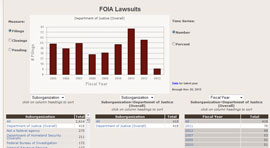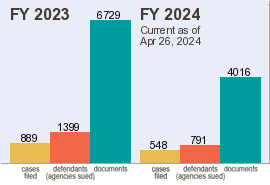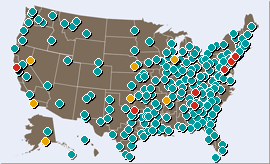About Agency Backlog and Processing Time Tool
The Agency Backlog and Processing Time data tool lets you examine current FOIA backlogs and processing times for federal agencies that have provided data to this project thus far. The FOIA effort to obtain this data is an ongoing process. If you would like to see an agency added to this tool, you can volunteer to “Adopt an Agency” to assist in this effort.
How to Use the Tool
- Start by selecting the agency you are interested in from the scrollable list to the left of the chart area.
- Next, select whether you want to graph a Number (count of requests) or Ave. Days (processing time).
- Finally, select whether you want to graph Closings (requests the agency has already processed and closed) or Pending requests (backlog).
Following these procedures will generate an interactive line graph. To see the precise number at any given time, scroll over the line and the count will be displayed.
Interpreting the Chart
| If you select: | The data points on the line graph will display: |
| Number and Closing | The number of FOIA requests the agency closed in each month. |
| Number and Pending | The number of requests that were pending at the end of each month. |
| Ave. Days and Closing | The average number of calendar days it took to process FOIA requests that were closed that month. |
| Ave. Days and Pending | The average number of calendar days open FOIA requests had been pending as of the end of that month. |
Agencies assign different tracks to FOIA requests, based on their complexity and whether expedited processing was granted. This data tool allows you to examine time to closure and pending times for FOIA requests placed into different tracks.
The tool is built to allow for many types of comparisons by selecting more than one option at once. So you can compare closing and pending times within an agency by selecting both “closings” and “pending.” Likewise, you can compare agencies by selecting more than one agency at once. You can also compare processing times within an agency based on track assigned by selecting more than one track at once.
Once you select an option, you can unselect it by clicking on it again.
Note that the intervals used on the vertical (y) axis may change, depending on the values needed to display the agencies and items you selected. When more than one agency is clicked, the scale may need to stretch to accommodate the largest values. If you find you have selected agencies with very different values — for example, one that processes a lot of requests and one that does not — the scale may not allow you to see the variation present in the smaller agency’s numbers. Unselect the agency with the larger values to expand the scale used to display the agency with the smaller values.
The Transactional Records Access Clearinghouse (TRAC) at Syracuse University, which administers the FOIA Project, is working to provide comprehensive statistical information on the processing of FOIA requests to complement its authoritative collection of every FOIA lawsuit against the government over the past several decades. Working toward this goal, we have requested information on the processing of FOIA requests for over 20 of the most frequently sued agencies under FOIA. The agencies represented here are the ones that have provided usable data in response to these FOIA requests (for further details, see About Agency Backlog and Processing Time Data). Requests for updated data are submitted every three months. We updated this tool as we receive new data..
If you have questions, comments or concerns, or want to volunteer to “Adopt an Agency” so that it can be included in these data, please contact us using the form below:
 Recent Tweets
Recent Tweets


